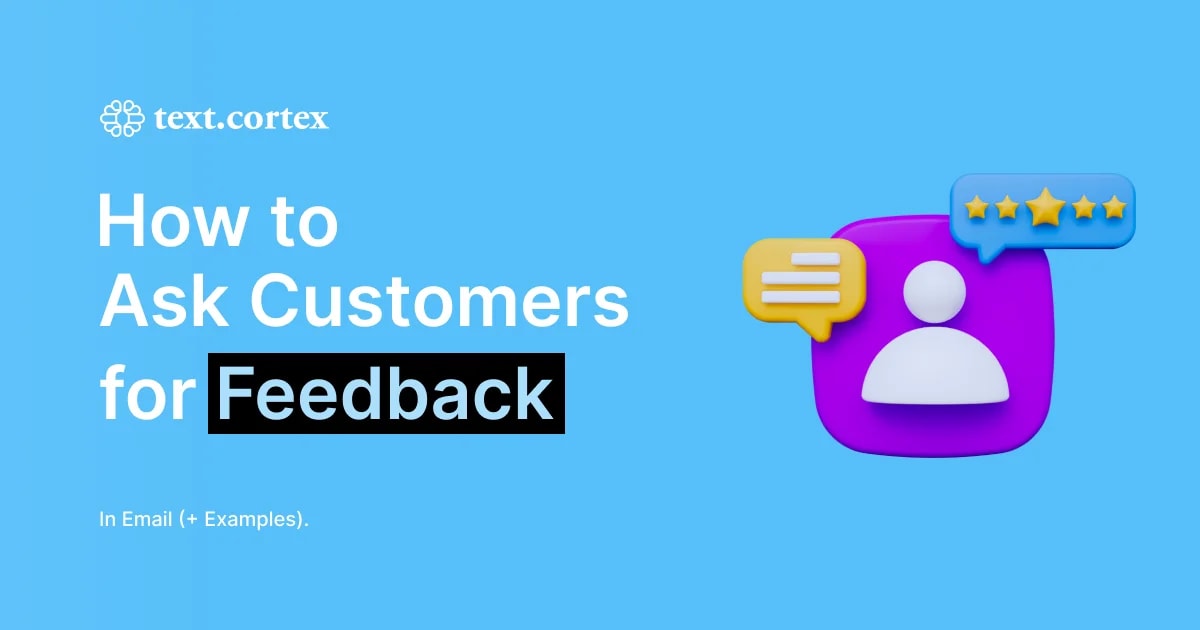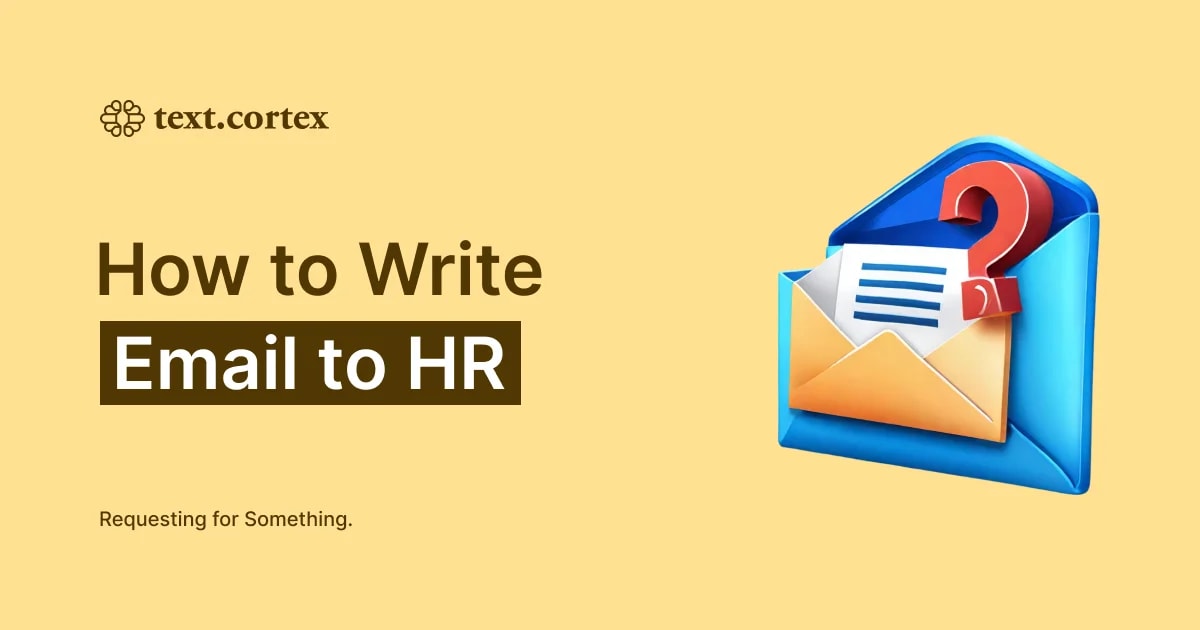How to write a maternity leave email that is not too short nor goes into extensive details?

Surely, not like Jim Carry in this GIF, even though it’s possible once you master it. 😆
Effective communication is crucial in business, especially when dealing with significant life events such as maternity leave.
A well-planned maternity leave email is essential for a smooth transfer and project continuity.
This text will review how to write a maternity leave email, help you understand your company policies, and use technology for remote communication.
Let’s dive deeper into essential tips on how to write such emails and the rules you must follow!
What Is a Maternity Leave Email?
A maternity leave email is a professional communication that notifies an employee's forthcoming maternity leave, stating the anticipated duration and defining project continuity measures.
It links the personal and professional worlds, informing and preparing colleagues for the temporary absence.
This email usually contains essential information like the due date, proposed leave dates, and contact information for any urgent work-related concerns.
It demonstrates a healthy balance of personal and professional commitments, producing a positive working culture.
Key Points to Include in Your Maternity Leave Email
There are rules for every type of professional email and key points they must include.
Let’s take a look at key points of maternity leave emails:
- Name of the employee: Includes your full name.
- Job title: A short title reflecting a person's position and duties inside a specific group or business.
- Your request for maternity leave: A formal statement submitted by an employee to their employer.
- Due date of the employee's child: The anticipated date when the employee expects to give birth or become a parent.
- Statement of informing employer: Indicates that the employee told their supervisor of either their pregnancy or the anticipated delivery date.
- Maternity leave duration: Decide on the duration of your maternity leave by selecting the number of weeks to take off from your job.
- Statement of employee's intention: Your intention to return to work following your leave.
- The planned return date: Approximate date of your return to the job.
How To Write Maternity Leave Email In 8 Easy Steps
The process of crafting a maternity leave email requires careful consideration and a balance between professionalism and personal touch.
Let’s go through the key steps.
1. Go Over the Maternity Leave Policies Established by Your Company
As a working individual, knowing and understanding your company's maternity leave policies is essential.
Taking advantage of these policies ensures that new parents have the necessary time to recover both physically and mentally after childbirth or adoption, as well as bond with their newest family member.
.jpg)
Additionally, reviewing parental leave policies could help you identify any gaps or areas in need of improvement, which in turn could benefit future new parents in the company.
2. Add the Recipient’s Name and Address in the Designated Sections
Adding the recipient's name and address in the designated sections is equally important when creating a formal letter.
This personalizes the correspondence, ensures that it reaches the intended recipient, and helps establish a professional tone for the communication.
3. Write a Subject Line
Craft a compelling subject line that captures the essence of your maternity leave email.
Ensure it effectively communicates the purpose while grabbing the recipient's attention and ensure it doesn’t go to a spam folder.
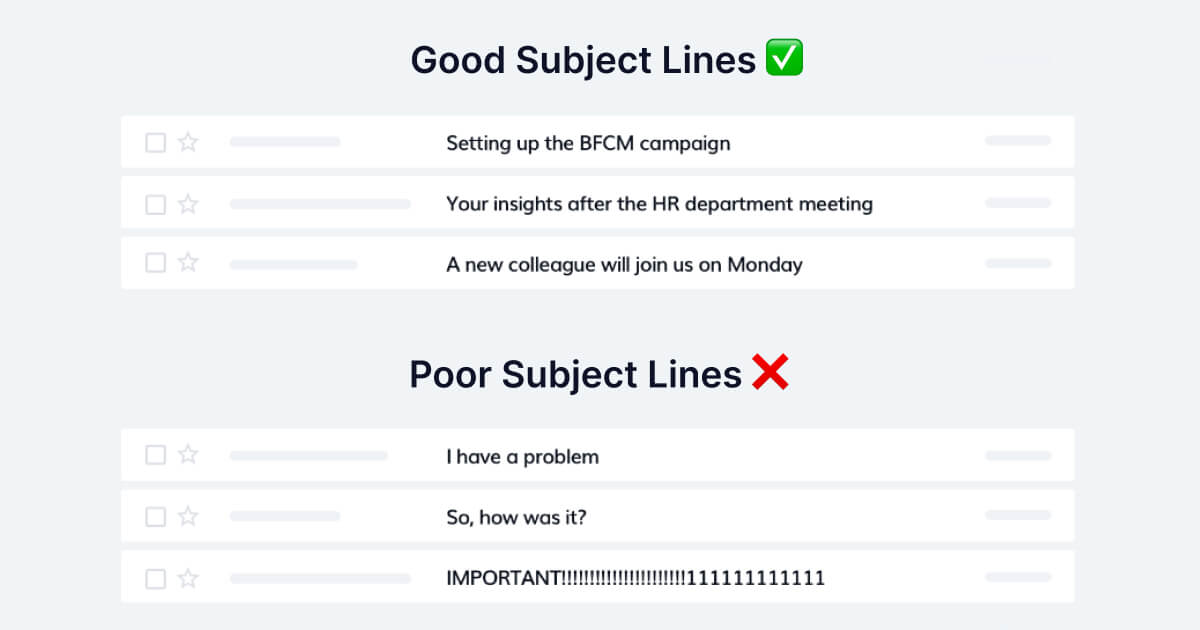
⭐Pro Tip⭐
TextCortex features ZenoChat, an intelligent AI assistant capable of creating various email subject lines.
It provides a variety of Personas to pick from, or you may create your own to vary the tone or style in which ZenoChat writes.
Asking ZenoChat to provide subject lines for maternity leave emails will result in various possibilities that you can choose from.
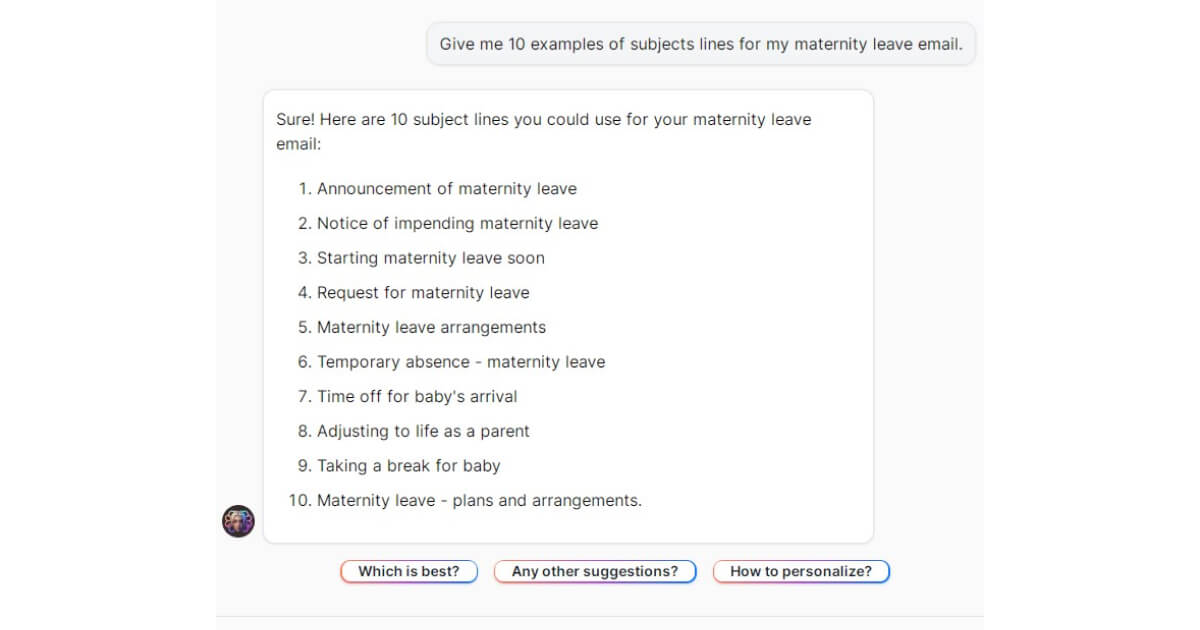
4. Provide a Brief Greeting to the Recipient
A brief greeting can help build a positive relationship and set the tone for professional communication.
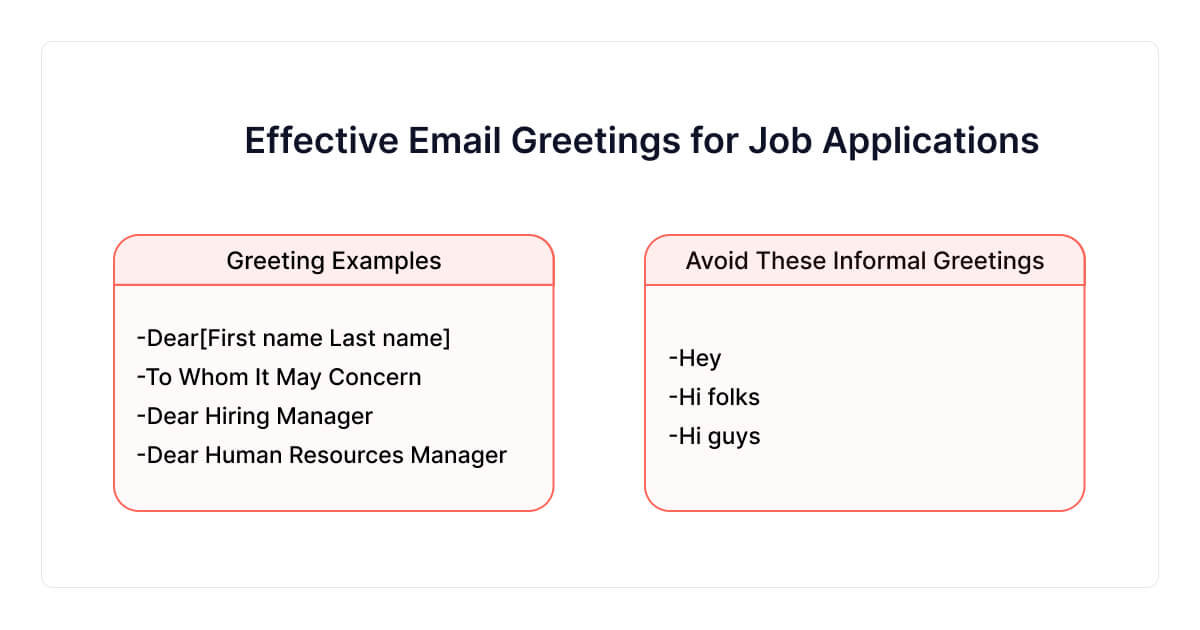
Keep the greeting courteous and appropriate for the context of the message, and tailor it to the recipient's position and level of familiarity.
By doing so, you will be able to open the lines of communication in an engaging and personable manner.
5. Propose an Alternate Work Arrangement During Your Absence
Proposing an alternate work arrangement can ensure that your responsibilities are still fulfilled without causing additional pressure on your colleagues or the company.
This could involve arranging for another team member to cover your duties while you're away or exploring flexible working options such as remote work or flexible hours.
By proposing these alternatives, you demonstrate your commitment to your job and willingness to find a practical solution that works for you and the company.
It's important to approach it by presenting a clear plan that outlines how the arrangement will work and how you will ensure that your workload is managed effectively during your absence.
Doing so can minimize potential disruptions and ensure you stay connected with your team while you're away.
Here are some ideas:
- Remote Part-Time Work: Propose a schedule where you work a few hours a day or certain days of the week remotely.
- Job Sharing: Suggest a job-sharing arrangement where a part-time employee or a colleague with similar skills shares your workload.
- Temporary Replacement: Recommend hiring a temporary worker or intern to fill in for you during your maternity leave.
- Delegating Tasks to Team Members: Identify key tasks that could be temporarily assigned to other team members.
- Utilizing Freelancers or Contractors: For specialized tasks, suggest the use of freelancers or contractors who can step in on a project basis, ensuring that specific skills and expertise are available when needed.
6. Specify the Method and Level of Communication You Would Prefer
When it comes to communication at work, it's important to establish clear boundaries and expectations.
Specifying the method and level of communication you prefer can help ensure that your colleagues or employees know your availability and preferred communication style.
For instance, you may prefer to communicate primarily through email or instant messaging rather than phone calls or face-to-face meetings.
Additionally, you might prefer certain times of the day when you are more receptive to inquiries or requests.
By communicating these preferences, you're setting expectations for others and making it easier for others to communicate with you.
7. Conclude the Leave Application by Providing Your Signature
It's important to conclude your leave application by providing your signature.
This confirms that you understand the terms and conditions associated with the leave and gives the application a personal touch, making it more official and professional.
By signing, you demonstrate your responsibility and commitment to your employer, which can aid in developing trust and a strong working relationship.
8. Make Sure Your Email Is Error-Free by Utilizing AI Tools
Sending an email without errors can help your professional reputation and improve your ability to communicate your message correctly.
This is where utilizing AI tools comes in handy, as countless online tools and software can help you detect and correct errors.
These tools can fix grammatical and spelling errors, suggest better sentence structure, and help streamline your writing.
In addition, they can also provide more sophisticated features such as tone, language, and sensitivity analysis.
⭐Pro Tip⭐
TextCortex can be a very helpful tool for writing a maternity leave email. ZenoChat's AI-powered chatbot can quickly access a database or knowledge base and retrieve any resources needed to write the email, such as common maternity leave policies, templates, and sample emails.
You can simply ask the chatbot to suggest keywords or phrases to include in your message, and it can generate several drafts that you can choose from.
TextCortex AI also offers a rewriting tool that can suggest professional language and ensure your email is error-free.
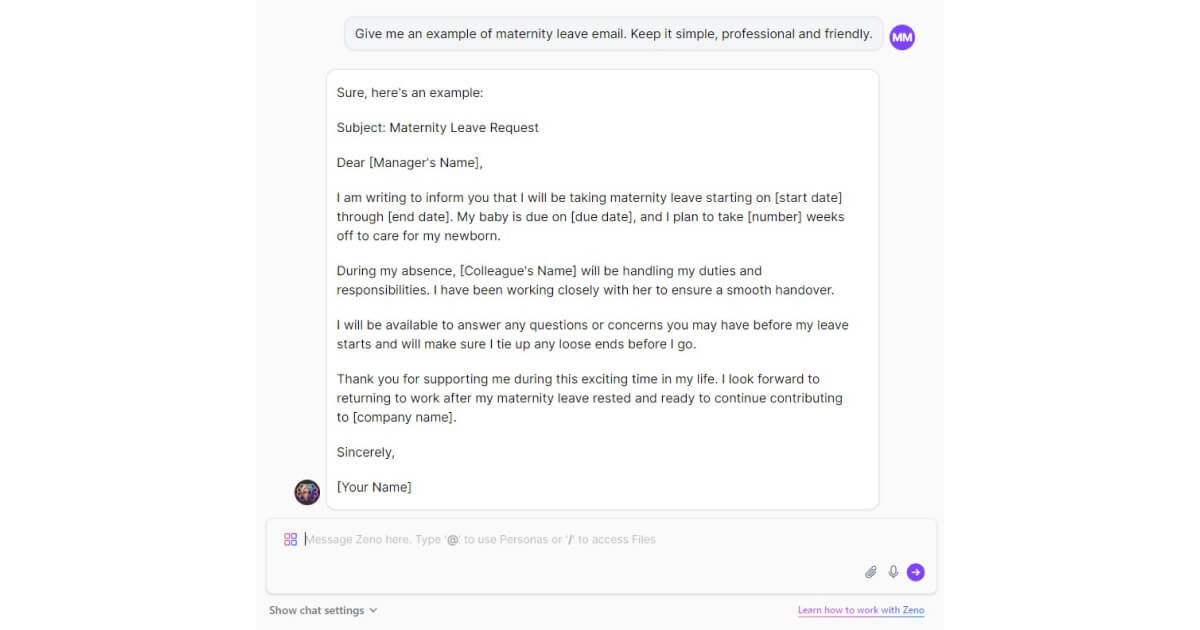
Maternity Leave Email Examples: Three Illustrative Samples
Explore these three illustrative examples that will help you understand how to write a maternity leave email.
Example 1:
Subject: Maternity Leave Request
Dear [Manager’s Name],
I am writing to request a maternity leave of [insert number of weeks/days here] starting from [insert start date] as I am expecting my first child in a few weeks. I plan to return to work on [insert return date or state that return date will be determined at a later point].
During my absence, I will ensure that all my projects are up to date and that a colleague in my department will handle my responsibilities.
I will also make sure to complete any pending tasks before I go on leave.
Please let me know if there are any additional steps I need to take or any paperwork that needs to be filled out.
Thank you for your support during this time.
Sincerely,
[Your Name]
Example 2:
Subject: Maternity Leave Announcement
Dear Colleagues,
I am happy to announce that I will take maternity leave starting from [insert start date] as my baby is due soon. During my absence, I will be unavailable by business email and phone.
I have planned for my responsibilities to be handled by [insert name and/or department] while I’m on leave. I will be reachable at my personal email address should anything urgent come up.
Thank you for your understanding and support during this time. I will be back in the office on [insert return date or state that return date will be determined at a later point].
Best regards,
[Your Name]
Example 3:
Subject: Update on Maternity Leave
Dear [Manager’s Name],
I wanted to provide you with an update on my maternity leave. My baby was born on [insert date], and both baby and I are doing well.
Per our previous discussion, I plan to return to work on [insert return date or state that return date will be determined later]. I will be available to gradually transition back to work to ensure a smooth handover of responsibilities.
Please let me know if there have been any changes in my absence or if any additional steps are required.
Thank you for your cooperation.
Sincerely,
[Your Name]
To Wrap Things Up
This guide has outlined the crucial steps for effective communication during your maternity leave announcement, provided some examples, and pinpointed crucial parts of how to write a maternity leave email.
If you need any further help or guidance on crafting your message, our team at TextCortex is always ready to assist you.
Please don't hesitate to contact us for support, as our resources can help you enhance your communication skills and ensure that you send your message seamlessly and professionally to your colleagues and superiors.
Are you up for giving it a shot?
Sign up for TextCortex for free, and use 20 daily creations to generate maternity leave emails!
FAQ
When Should I Send the Maternity Leave Email?
Aim to send your maternity leave email at least a few weeks before your planned leave. This allows your team and superiors to make necessary arrangements.
What Information Should I Include In My Maternity Leave Email?
Provide the expected start and end dates of your maternity leave. Mention any handover plans or the person responsible during your absence. Be sure to include your contact information in case of emergencies.
How Personal Should I Get In My Maternity Leave Email?
It's okay to share a brief personal note about your excitement, but keep it professional. Avoid oversharing personal details.
How Formal Should the Tone Be?
Maintain a professional and positive tone. It's a formal communication, but you can still convey your excitement for the upcoming changes.

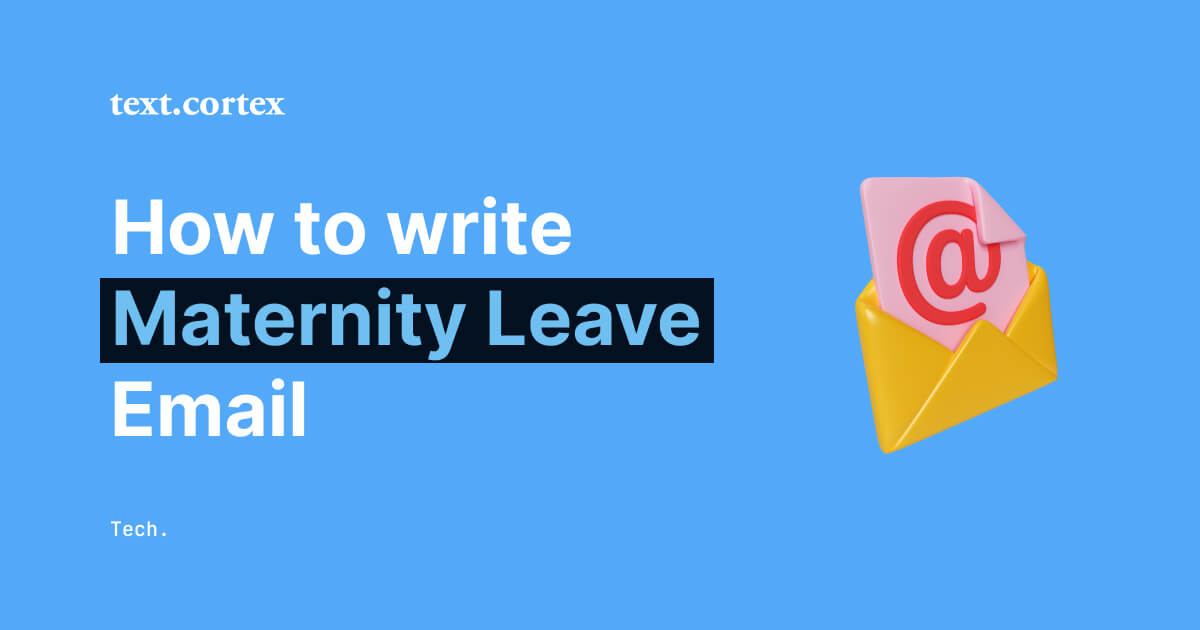
.webp)
